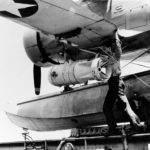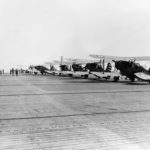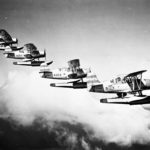Seagulls off the heavy cruiser Indianapolis in flight during World War II
Curtiss SOC-2 code 6-CS-1
Curtiss SOC Seagulls PTO January 1943
Floatplane SOC Seagull launched from catapult of New Orleans-class cruiser 1943
Curtiss SOC of the VCS-7 July 1943
The first SOC-1 Seagull 9856 30 October 1935
Curtiss SOC-3 stripped for maintenance in the hangar of USS Savannah (CL-42) 1938
SOC-1 Seagull 9979 2 July 1939 in flight
Curtiss SOC-1 BuNo 9880 1935
SOC Seagull with Mark XVII depth bomb 325lb on board USS Philadelphia (CL-41) 2 July 1942
Curtiss SOC-4 Seagull V172 of the U.S. Coast Guard
SOC-3 Seagull of VO-2B 1938, plane from USS California (BB-44)
Curtiss SOC-1 Seagull 9856 with folded wings
Curtiss SOC-3 from VO-2B parked at Reeves Field, San Diego in 1938
SOC-3A 1-GS-12, pilot: LCDR Lex L. Black of VGS-1 – 20 April 1942
SOC Seagull of the VCS-7 England June 1944
Curtiss SOC-3A 1-GS-5 of VGS-1 is launched by catapult 21 May 1942
SOC Seagull drops a message as it flies over USS Augusta (CA-31), North Africa in November 1942 – Operation “Torch”
Floatplanes SOC-2 Seagulls 1936
First Curtiss SOC-1 9856 at NAS Anacostia, September 1935
Floatplane SOC-2 Seagull BuNo 0417 in flight
SOC-3A Seagull of VS-201 parked on the flight deck of USS Long Island (CVE-1), 16 December 1941
Curtiss SOC-3A of VGS-1 parked on the flight deck 10 May 1942
Curtiss SOC-3A 201-S-2 of VS-201 parked on the flight deck of USS Long Island (CVE-1), 16 December 1941
Curtiss SOC with Mark XVII depth bomb 325lb on board USS Philadelphia (CL-41) – 2 July 1942 2
SOC Seagull is lowered onto the port catapult of USS Minneapolis (CA-36) during Wake Raid – 5 October 1943
Floatplanes SOC from USS Honolulu (CL-48) fly in a formation. VCS-9 1938-39
Floatplane Curtiss SOC #2 takes off from USS Minneapolis (CA-36) during Wake Raid 5 October 1943
The XO3C-1 Seagull was built towards the end of the new era preceding the development period leading up to World War II. Although it resembled the tube-and-fabric biplanes of the mid-1920s, it did not signify a regression in Curtiss technology. The Navy had specified the design, which was in competition with equivalent designs from Vought and Douglas. Its ‘modern’ features were limited to full-span leading-edge slats on the upper wing, trailing-edge flaps on the upper wing, and a cowling around the Pratt & Whitney Wasp radial engine. This was Curtiss’s second aircraft to bear the name Seagull, which became official when the US Government adopted names for military aircraft in October 1941. The XO3C-1 won large-scale production orders for the 1935-38 period under the designation SOC in the Navy’s new Scout-Observation class established in 1934. By the late 1930s, the SOC and their Navy-built duplicates had a monopoly on the US Navy’s battleship and cruiser catapult seaplane roles. Despite being due for replacement in 1941, these aeronautical anachronisms outlived their intended replacements and served with the fleet until the end of the war.
The XO3C-1, Navy BuNo 9413, was built at Buffalo and was originally an open-cockpit observation biplane with backward-folding wings. Its structure comprised a welded steel-tube fuselage and aluminum-frame wings and empennage, all covered with fabric. Full-span ailerons were fitted to the bottom wing, and full-span flaps to the upper. Armament consisted of a single fixed 7.62mm machine gun in the nose and a single 7.62mm on a swivel mount in the rear cockpit. The single prototype cost $113,445 less Government-Furnished Equipment (GFE). The XO3C-1 was tested in March 1934 as an open-cockpit seaplane with an amphibious single float. It was soon modified to production SOC standard with enclosed cockpits, upper-wing ailerons, and a single-strut undercarriage, prior to being redesignated XSOC-1 on 23 March, 1935, the date the first production models were ordered. The SOC’s basic construction was tube-and-fabric, and the only ‘modern’ features it displayed were full-span leading-edge slats on the upper mainplane, trailing-edge flaps on the upper mainplane, and a substantial cowling around the engine. The prototype had an amphibious undercarriage that incorporated a twin-wheel retractable landing gear. Production aircraft were built as pure seaplanes with the option of a fixed main undercarriage and tailwheel; either option was not difficult to apply. The wings, which could be folded, and the tail unit were made of lightweight alloy. Both the pilot and observer/gunner operated from tandem cockpits under a transparent canopy. The “turtleback,” or upper rear fuselage, could be retracted to improve the rear field of fire. The XO3C-1 prototype made its first flight in April 1934 and the first SOC-1s were put into service with the USS Marblehead on November 12, 1935. VS-5B, VS-6B, VS-9S, VS-10S, VS-11S, and VS-12S were among the first units to receive the SOC-1, with deliveries continuing until 1938, at which point the SOC was widely used in the US Navy. The US Navy began to gradually replace its SOC fleet with the Vought Kingfisher in 1941, and it was expected that the SOC Seagull, as it was known only from 1941, would be replaced by the SO3C Seamew. However, the Seamew proved to be a failure, leaving the US Navy with no choice but to bring the Seagull back into operational units from 1943 onwards, where it served for the remainder of the war. As Kingfisher production increased, the Seagull was eventually phased out but continued to serve as trainers and general communication aircraft until they were removed from the inventory in 1945.
Total produced: 309
Variants:
- XO3C-1 (Model 71) – prototype aircraft tested in March 1934, powered by 550 hp (410 kW) Pratt & Whitney R-1340-12 engine. One built, redesignated XSOC-1 on 23 March 1935.
- SOC-1 (Model 71A, BuNo 9856-9990) – first production version, with 550 hp Pratt & Whitney R-1340-18 engine enclosed in NACA cowling, ailerons added to the top wing, and a large canopy enclosing both cockpits. Interchangeable float and wheeled undercarriage. 135 built.
- SOC-2 (Model 71B, BuNo 0386-0425) – 40 SOC with R-1340-22 engine. Wheeled undercarriage only.
- SOC-3 (Model 71E, BuNo 1064-1146) – sSimilar to SOC-2, but with interchangeable undercarriage. 83 built.
- SOC-3A – SOC-3 modified to operate on wheels from escort carriers
- SOC-4 – (Model 71F) – 3 U.S. Coast Guard SOC-3 Seagulls produced by Curtiss in 1938. All were transferred to the U.S. Navy in 1942 (call numbers V171-V173; BuNo 48243-48245), which modified them to SOC-3A standard, to operate on wheels from escor carriers.
- XSO2C – (Model 71C, BuNo 0950) – prototype based on the SOC-3, but with a 5-foot fuselage stretch and powered by a Pratt & Whitney R-1340-36.
- SON-1 (BuNo 1147-1190) – SOC-3 aircraft produced by the Naval Aircraft Factory, 44 built.
Bibliography:
- Steve Ginter: Curtiss SOC Seagull Naval Fighters Number Eighty-Nine
- William T. Larkins: The Curtiss SOC Seagull Aircraft Profile Number 194
- Curtiss: Company Profile 1907-1947 Aeroplane Company Profile, 2014
- Peter M. Bowers: Curtiss Aircraft 1907-1947
- John M. Elliott: The Official Monogram U.S. Navy & Marine Corps Aircraft Color Guide Vol. 2 1940-1949
- Thomas E. Doll, Barkley R. Jackson: Navy Air Colors: United States Navy, Marine Corps, and Coast Guard Aircraft Camouflage and Markings Vol. 1 1911-1945; Squadron/Signal Publications 6159
- Gordon Swanborough, Peter M. Bowers: United States Navy Aircraft since 1911



























